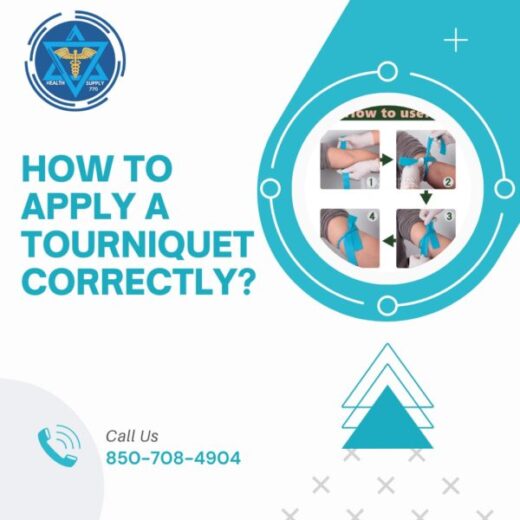From the start of the treatment of diseases, medical science has invented numerous devices to assist in the treatment of diseases. These devices or equipment are of great value as they help in the smooth running of medical procedures and are also efficient and time-saving. This medical equipment can help save lives if used correctly and timely. Such equipment that has been in the use of humans for the past several centuries is a tourniquet. Today in this article we are going to discuss what a tourniquet is and how it is used. So let’s not delay further.
What is a tourniquet?

Tourniquet
Simply put, a tourniquet is an extremely important medical device that is used to control and slow bleeding. When applied correctly, a tourniquet can stop bleeding. It does so by applying pressure to a limb or extremity and helps save the patient’s blood which can be lifesaving. These are often used in emergencies to temporarily control blood flow and are also a part of first aid.
The use of tourniquets dates back to the fourth century BC when it has been reported that the army of Alexander the Great used tourniquets to help wounded soldiers and control their bleeding. Romans used tourniquets to control bleeding during the process of amputations.
Apart from this, a tourniquet was considered to be of great value in military campaigns as shown by the fact that it was introduced to every soldier of the royal navy and was asked to have his tourniquet with him during the battle. The purpose of doing so was to save the soldiers from excessive blood loss before receiving medical treatment.
How to apply a tourniquet?
Tourniquets are mostly applied in emergencies on legs or arms to control bleeding. This helps to slow down the bleeding process which can help to save a limb or a life. A tourniquet cuts off the blood supply to a limb and thus helps prevent life-threatening blood loss. When used correctly, it can help slow the blood flow until medical help is given. However, always using a tourniquet to stop bleeding is not necessary.
First direct pressure should be applied to the wound using gauze or a clean cloth. If the dressing you used to apply the pressure becomes soaked with blood and the blood continues to flow, then you should use a tourniquet. If you cannot stop the bleeding by applying direct pressure, only then you should use a tourniquet. Now, a tourniquet can be applied to bare skin and also over clothing. However, sometimes it is preferable and easier to remove the clothing and then apply a tourniquet.

Tourniquet application
The process of applying a tourniquet is as follows:
Identify the source of bleeding
The first thing you need to do is to identify the source of blood. In some cases, the source of bleeding might be obvious but it can be a challenging task if there is wreckage, debris, or other objects.
To find the source of the bleeding, have the injured person lie down. It will allow you to check the person from head to toe and find the source of bleeding sooner. You need to find the source of the bleeding as soon as you can to save blood.
Apply pressure
Apply pressure on the wound using a dressing and if the blood flow does not stop, then apply a tourniquet. Before applying a tourniquet, you must tell the injured person that it is going to hurt extremely but it is important to save the limb or their life. It will help the patient to become mentally ready to face the procedure.
Position the tourniquet
It is the most critical part of the process. First, you should remove any clothing on the wounded area and then apply a tourniquet several inches above the injury. According to the American Red Cross, a tourniquet should be placed 2 inches above the wound and should never be used directly on a joint. Also, it should be placed on the part of the limb which is closest to the heart.
Secure the tourniquet
After placing the tourniquet, you should secure it by pulling the strap of the tourniquet tight and twisting the windlass. Twisting the windlass will increase the pressure over the area and slow down the bleeding. You need to twist the windlass until you see a significant reduction in the blood flow. When you notice that the bleeding has stopped or slowed down, you should tie one or both ends of the windlass to the patient’s arm or leg and secure it in its place.

Securing a tourniquet
Time the duration of applying the tourniquet
Tourniquets should not be applied for longer than two hours. Using a tourniquet for more than two hours can be life-threatening as it can cause permanent nerve injury, muscle injury, vascular injury, and skin necrosis. Therefore, it is important to note the time of applying the tourniquet so that these problems can be avoided. Some tourniquets also have a white space which can be used to mention the time of applying the tourniquet.
Removal of the tourniquet
A tourniquet should only be removed by a healthcare provider in the emergency department. It should never be removed by any other person outside the emergency department.
Stay with the patient
The person who applied the tourniquet should stay with the patient till healthcare providers arrive as they may want to know important information regarding the timing of applying the tourniquet and other matters.
Conclusion
Applying a tourniquet correctly may not need proper training but it should be done in the proper and accurate order to help prevent blood loss. The person applying the tourniquet should stay calm and focused during the process and must have basic information regarding the procedure. When used correctly and on time, tourniquets can save limbs and lives. But these should be used with extreme care and for a measured period to avoid complications. Using a tourniquet can be a lifesaver for patients in emergencies.

PhD Scholar (Pharmaceutics), MPhil (Pharmaceutics), Pharm D, B. Sc.
Uzma Zafar is a dedicated and highly motivated pharmaceutical professional currently pursuing her PhD in Pharmaceutics at the Punjab University College of Pharmacy, University of the Punjab. With a comprehensive academic and research background, Uzma has consistently excelled in her studies, securing first division throughout her educational journey.
Uzma’s passion for the pharmaceutical field is evident from her active engagement during her Doctor of Pharmacy (Pharm.D) program, where she not only mastered industrial techniques and clinical case studies but also delved into marketing strategies and management skills.
Throughout her career, Uzma has actively contributed to the pharmaceutical sciences, with specific research on suspension formulation and Hepatitis C risk factors and side effects. Additionally, Uzma has lent her expertise to review and fact-check articles for the Health Supply 770 blog, ensuring the accuracy and reliability of the information presented.
As she continues her PhD, expected to complete in 2025, Uzma is eager to contribute further to the field by combining her deep knowledge of pharmaceutics with real-world applications to meet global professional standards and challenges.








